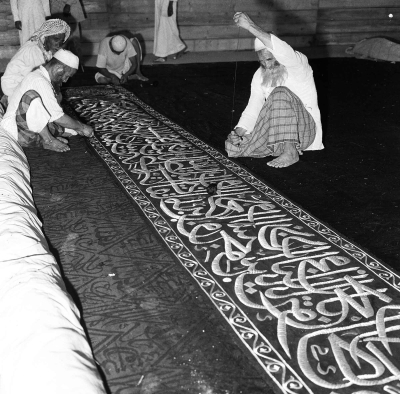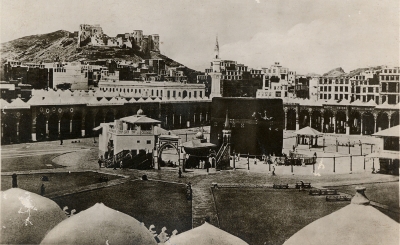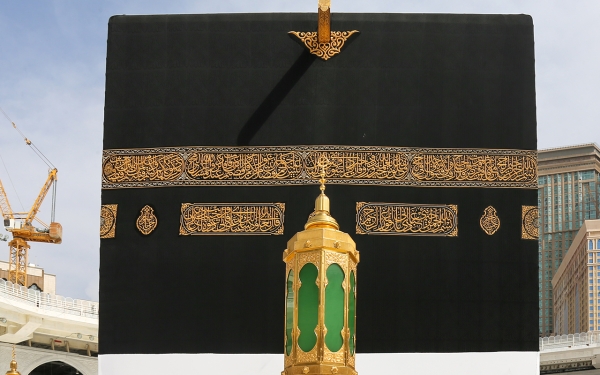
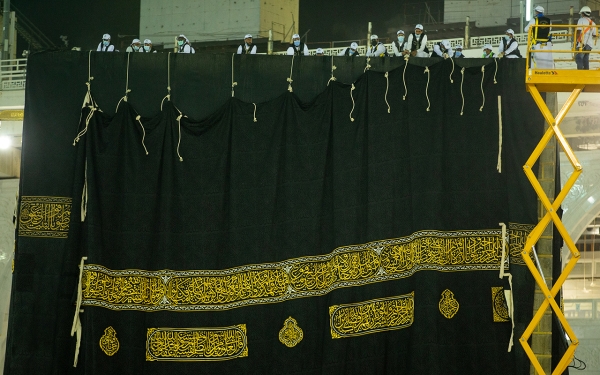
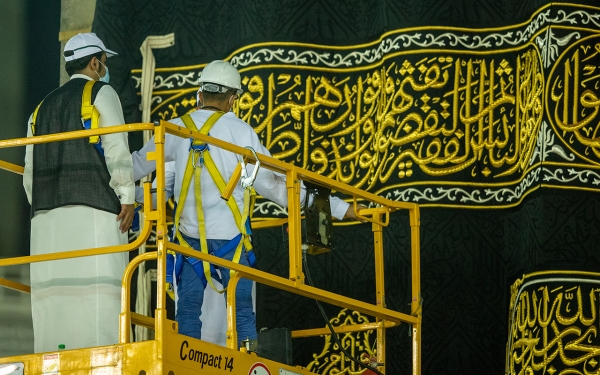
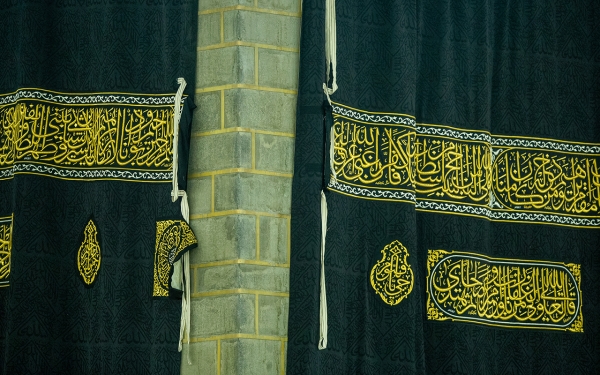
Al-Kaaba's Kiswa is the piece of cloth that covers al-Kaaba al-Musharrafah. It is woven with silk, gold, and silver threads on an annual basis. This tradition dates back to the construction of al-Kaaba until the era of the Founder of the Kingdom of Saudi Arabia, King Abdulaziz Bin Abdulrahman Al Saud, who regulated the affairs of the Kiswa and ordered the establishment of a factory for manufacturing al-Kaaba al-Musharrafah's Kiswa in Makkah al-Mukarramah. In 1927, the factory was established in Ajyad Neighborhood, facing the Ministry of Finance building in Makkah al-Mukarramah. The Kiswa's annual cost (in 2022) exceeds about SAR20 million. The garment weighs around 980 kg and consists of 760 kg of black silk, 120 kg of gold wire, and one hundred kg of silver wire, divided into forty-seven pieces of cloth, measuring 98 cm wide and 14 cm high. It is sewn at the King Abdulaziz Complex for al-Kaaba Kiswa (King Abdulaziz Complex), which is affiliated with the General Presidency of the Grand Mosque and the Prophet's Mosque located in Oum al-Jood in Makkah al-Mukarramah, to ensure it is ready for replacement.
Delivery of al-Kaaba's Kiswa
A supreme order was issued on Monday, July 4, 2022, stipulating that al-Kaaba al-Musharrafah's Kiswa is delivered to the senior caretaker of al-Kaaba on Eid al-Adha, corresponding to the tenth day of Dhu Al-Hijja, and the annual replacement of the Kiswa should take place on the first day of Muharram
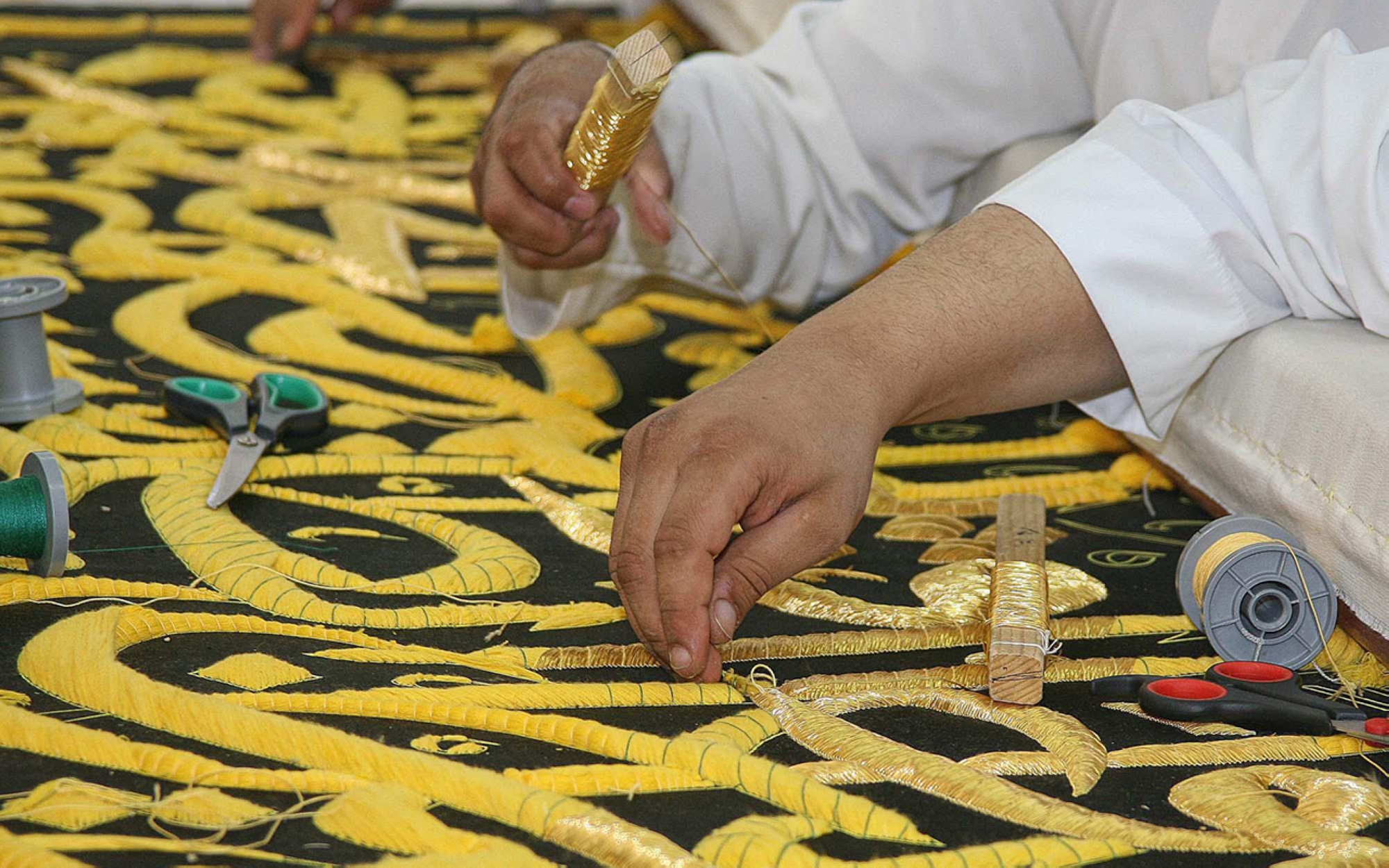
Stages of manufacturing al-Kaaba's Kiswa
The Kiswa manufacturing process involves several artistic and operational departments, comprising 220 artisans and technicians. It commences with the dyeing stage, which marks the initial phase of Kiswa production at the factory. The dyeing department receives pure natural silk, which is then transferred to an automated fabric sewing machine containing Quranic verses. Subsequently, the laboratory department conducts various tests on the silk and cotton threads to ensure they meet the required standard specifications. These tests assess the silk threads’ tensile strength and resistance to erosion factors, alongside conducting necessary research and experiments. Following this, the printing stage ensues, involving the Belt and Embroidery Department, the Kiswa Sewing Department, and finally, al-Kaaba al-Musharrafa's Kiswa Care Unit.
Upon completion of all stages of production and manufacturing, and in the middle of the month of Dhu al-Qadah, an annual ceremony is held at al-Kaaba al-Musharrafah's Kiswa factory. The Kiswa is then delivered to the senior caretaker of al-Kaaba, who in turn delivers it to the head of religious affairs at the Grand Mosque and the Prophet’s Mosque. In 2021, a supreme order was issued stipulating that al-Kaaba's Kiswa should be delivered on the tenth day of Dhu al-Hijjah.
The final step in the installation process involves the "Sitarah Bab al-Kaaba al-Musharrafa," (curtain of al-Kaaba's door). This phase is regarded as one of the most challenging stages in replacing the Kiswa. Following this, the Kiswa, adorned with robust white cloth pieces, is elevated approximately three m from the Shadherwaan, the marble base of al-Kaaba. This is referred to as the "Ihram of al-Kaaba." Ultimately, the Kiswa is raised into place.
History of al-Kaaba's Kiswa
The history of the Kaaba's Kiswa dates back to what was mentioned about Adnan Bin Iid, the great-grandfather of the Prophet, peace be upon him (PBUH), as one of the individuals who covered it. It has also been reported that Tubh al-Houmyari, the king of Yemen, was the first to cover it during the pre-Islamic era, after his visit to Makkah. He was the one who constructed a door and provided a key for al-Kaaba.
After Tubh al-Houmyari, many covered the Kaaba during pre-Islamic times. It was not until Qusay Ibn Kilab, the fourth grandfather of the Prophet (PBUH), took matters into his own hands and regulated it after he gathered the tribes of his people under one legion, suggesting that they cooperate with each other. Then came Abu Rabia Abdullah Bin Amr al-Makhzoumi, a wealthy merchant, who proposed to the Quraysh tribe, "You cover al-Kaaba one year, and I will cover it the year after." The Quraysh agreed to his proposal, and this process continued until Abu Rabia's death. The Quraysh tribe then inherited this task until the conquest of Makkah. This marked the beginning of the era of Islamic rule and the appearance of inscriptions on the Kiswa. In the era of the Umayyad rule, al-Kaaba was covered with two Kiswas per year; one on the day of Ashura, and the other at the end of the holy month of Ramadan, in preparation for Eid al-Fitr. Then the Abbasid Caliphs took it upon themselves to cover al-Kaaba al-Musharrafah. Due to the evolution of weaving, tailoring, dyeing, coloring, and embroidery, the Kiswa was weaved in Egypt. It was black, adorned with golden inscriptions and silver embroidery.
During the reign of Caliph al-Ma'mun, al-Kaaba al-Musharrafah was covered three times a year. The tradition of writing on the Kiswa began at the start of the Abbasid era. Caliphs would inscribe their names on the Kiswa, along with the place of its production and the date of manufacture.
The first person to cover al-Kaaba during the era of the First Saudi State was Imam Saud Bin Abdulaziz in 1806, when he covered it with pure red silk. One year later, he covered it with black silk.
The first Saudi Kiswa for al-Kaaba al-Musharrafah made in Makkah al-Mukarramah was ordered by the Founder King Abdulaziz Bin Abdulrahman Al Saud in 1927.
The kings of the Kingdom continued to care for al-Kaaba's Kiswa. King Abdullah Bin Abdulaziz gave approval to modernize and update the electronic systems, electrical appliances, and mechanical equipment at al-Kaaba's Kiswa factory, in accordance with the new systems. This step was a developmental shift in the field of al-Kaaba al-Musharrafah's Kiswa manufacturing. On April 29, 2018, the Custodian of the Two Holy Mosques, King Salman Bin Abdulaziz, also issued his approval to change the name of Factory of al-Kaaba al-Musharrafah's Kiswa to King Abdulaziz Complex for al-Kaaba Kiswa.
The wisdom behind covering al-Kaaba is rooted in Islamic ritual, following the tradition established by the Messenger of Allah (PBUH) and his esteemed companions. It is reported that after the conquest of Makkah, the Prophet (PBUH) draped al-Kaaba with Yemeni cloth, striped in white and red.
Related quizzes

